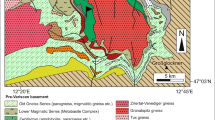Abstract
A new Sc-bearing variety of tusionite has been found in the Eastern Pamirs, in the near-miarolitic Dorozhny granite pegmatite complex at the Kukurt pegmatite field (left bank of the Kukurt River, 45 km east of the settlement of Murghab, Gorno-Badakhshan Autonomous Oblast, Tajikistan). Miarolitic pegmatites are related to the alpine leucocratic granites of the Shatput intrusive complex and occur in rocks of the Sarydzhilga Formation (PR3?) metamorphosed under amphibolite and epidote–amphibolite facies. Tusionite occurs in association with quartz, K-feldspar, albite, elbaite, Sc-bearing spessartine (up to 0.2 wt % Sc2O3) and accessory fluorapatite, Y-bearing fluorite, Sn-bearing titanite, magnetite, polycrase-(Y), B-rich gadolinite-(Y), ixiolite, manganocolumbite, pyrochlore, chernovite-(Y), cassiterite, varlamoffite, lepidolite, and Hf-rich zircon (up to 17.0 wt % HfO2). Tusionite forms thin lamellae (0.05–0.25 mm) and fanlike aggregates. It is yellow and transparent with a vitreous luster. It has weak pleochroism, No (orange–yellow) > Ne (light yellow). It is a uniaxial negative mineral, no = 1.870(5), ne = 1.760(3). The Raman spectrum has been reported for tusionite for the first time (laser excitation 532 nm); main bands: 228, 305, 379, 466, 661, 733, 750, 942, 1218, and 1458 cm–1. Its X-ray diffraction pattern is similar to tusionite from the Southwestern Pamirs. Hexagonal unit cell parameters: a = 4.772(3), c = 15.28(3) Å. Chemical composition (electron microprobe, wt %, average of 14 analyses): 0.06 (0.00–0.31) Ta2O5; 50.28 (49.43–51.03) SnO2; 0.02 (0.00–0.19) TiO2; 1.02 (0.62–1.53) Sc2O3; 0.03 (0.00–0.19) CaO; 0.21 (0.16–0.46) FeO; 24.06 (23.59–24.34) MnO; 24.51 (calc. 23.90) B2O3; total 99.62 (99.08–100.79). The substitution mechanism involving Sc is not clear. Substitution of Sc+3 for Sn+4 with partial replacement of Mn+2 by Mn+3 is possible; however, Sc negatively correlates not only with Sn, but also with (Fe + Mn), which may result from the location of Sc in both octahedral positions with Sn+4 and Mn+2.






Similar content being viewed by others
REFERENCES
Cooper, M.A., Hawthorne, F.C., and Taylor, M.C., The crystal structure of tusionite, Mn2+Sn4+(BO3)2, a dolomite-structure borate. Can. Mineral., 1994, vol. 32, pp. 903–907
Danisi, R.M., Armbruster, T., Libowitzky, E., Wang, H.A.O., Gunther, D., Nagashima, M., Reusser, E., and Bieri, W., Perettiite-(Y), \({\text{Y}}_{2}^{{3 + }}\) \({\text{Mn}}_{4}^{{2 + }}\)Fe2+[Si2B8O24], a new mineral from Momeik, Myanmar, Eur. J. Mineral., 2015, vol. 27, pp. 793–803.
Danisi, R.M., Armbruster, T., Libowitzky, E., Wang, H.A.O., Gunther, D., Nagashima, M., and Novak, M., Cassiterite and tusionite as monitors of B and Sn behaviour in the elbaite pegmatite at Řečice near Nove Mesto na Morave, Western Moravia, Czech Republic, Neu. Jb. Mineral., 1999, Mh. 11, pp. 481–493.
Diman, E.N. and Nekrasov, I.Ya., Hydrothermal synthesis of nordenskiöldine and its analogues. Dokl. Akad. Nauk Ukr. SSR, 1965, vol. 164, no. 4, pp. 894–897.
Dmitriev, E.A., Granite pegmatites of the Eastern Pamirs and specifics of their gemstone mineralization, Izv. Akad. Nauk Tadzhik. SSR, Ser. Geol. Fiz.-Tekhn Nauk, 1983, no. 3, pp. 73–81.
Dzhuraev, Z.T., Zolotaryov, A.A., Pekov, I.V., and Frolova, L.V., Hambergite from pegmatite veins of the Eastern Pamirs, Zap. Ross. Mineral.O-va, 1998, vol. 187, no. 4, pp. 132–139.
Kalacheva, L.V., Yamnova, N.A., Puscharovsky, D.Yu., and Konovalenko, S.I., The crystal structure of a new natural borate tusionite MnSn[BO3]2, Kristallografiya, 1992, vol. 37, no. 6, pp. l 1557–1559.
Konovalenko, S.I., Voloshin, A.V., and Pakhomovsky, Y.A., Anan’ev S.A., Perlina G.A., Rogachev D.L., and Kuznetsov, V. Y., Tusionite MnSn(BO3)2—a new borate from granite pegmatites of South-West Pamir, Dokl. Akad. Nauk Ukr. SSR, 1983, vol. 272, no. 6, pp. 1449–1453.
Li, D., Peng, M., and Bancrof, G.M., The vibrational spectra and structure of nordenskioldine, Can. Mineral., 1994, vol. 32, pp. 81–86.
McKeown, D.A., Raman spectroscopy and vibrational analyses of albite: rom 25°C through the melting temperature, Am. Mineral., 2005, vol. 90, no. 10, pp. 1506–1517.
Mitchell, A., Infra-red absorption of the orthoborate ion, Trans. Faraday Soc., 1966, vol. 62, pp. 530–533.
Nasdala, L., Smit, D.C., Kaindl, R., and Zieman, M.A., Raman spectroscopy: analytical perspectives in mineralogical research, Spectrosc. Methods Miner, 2004, vol. 6, pp. 281–343
Nekrasov, I.Y., Fazovye sootnosheniya v olovosoderzhashchikh system (Phase Relations in the Tin-Bearing Systems, Moscow: Nauka, 1976.
Peretyazhko, I.S., Prokof’ev, V. Y., Zagorsky, V. E., and Smirnov, S. Z., Role of boric acids in the formation of pegmatite and hydrothermal mineral genesis: petrologic consequence of sassolite (H3BO3) discovery in fluid inclusions, Petrology, 2000, vol. 8, no. 3, pp. 214–237.
Rossovsky, L.N. and Morozov, S.A., and Scrigitil, A.M., “Features of formation of myarolic pegmatites of Eastern Pamirs, Proc. Izv. Akad. Nauk SSSR, Ser. Geol., 1991, no. 5, pp. 92–103.
Scrigitil, A.M., Gemstones in pegmatites of Eastern Pamir, Mir kamnya (World of Stones), 1996, no. 11, pp. 11–17.
Smirnov, S.Z., Peretyazhko, I.S., Prokofev, V.Y., Zagorsky, V.E., and Shebani, A.P., The first finding of sassolite, (H3BO3) in fluid inclusions in minerals, Geol. Geofiz., 2000, vol. 41, no. 2, pp. 193–205.
Steele, W.C. and Decius, J.C., Infrared absorption of lanthanum, scandium, and indium borate and the force constants of borate ion, J. Chem. Phys, 1956, vol. 25, no. 6, pp. 1184–1188.
Zolotaryov, A.A., Jewelry and collection tourmaline from Pamir (crystallomorphology, colouring, crystallochemistry), Zap. Ross. Mineral.O-va, 1996, vol. 125, no. 4, pp. 32–46.
ACKNOWLEDGMENTS
We thank A.A. Agakhanov, A.R. Faiziev, and B.A. Alidodov for their assistance in organizing and conducting field work in the Eastern Pamirs; V.D. Shcherbakov, for his help in obtaining the Raman spectra of minerals; and I.V. Pekov, for valuable advice and attention to our research.
Author information
Authors and Affiliations
Corresponding author
Additional information
Translated by E. Maslennikova
Rights and permissions
About this article
Cite this article
Mirakov, M.A., Pautov, L.A., Shodibekov, M.A. et al. A New Scandium-Bearing Variety of Tusionite from the Eastern Pamirs (Tajikistan). Geol. Ore Deposits 61, 809–817 (2019). https://doi.org/10.1134/S1075701519080087
Received:
Revised:
Accepted:
Published:
Issue Date:
DOI: https://doi.org/10.1134/S1075701519080087




